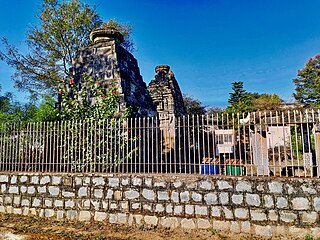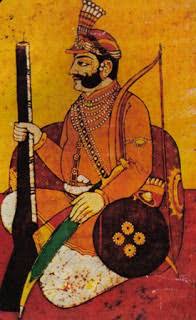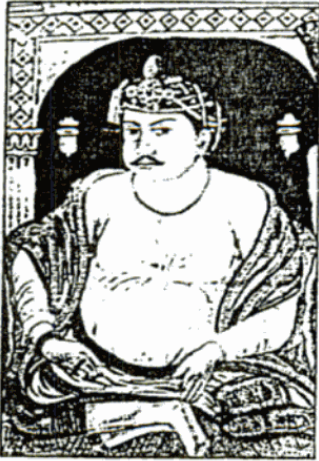
Gondwana, also known as Gondaranya, the land of Gondwana, is a region of India named after the Gondi people. The supercontinent, Gondwanaland, was named after the Gondwana region, because it contained some ancient fossil-bearing rock formations.

Bajirao I was the 7th Peshwa of the Maratha Confederacy. He after Shivaji is considered to be the most charismatic and dynamic leader in Maratha history. He was just twenty years old and already had a reputation for rapid decisions and a passion for military adventure. He is considered one of the greatest Military generals of his time.

Jabalpur, formerly Jubbulpore, is a city situated on the banks of Narmada River in the state of Madhya Pradesh, India. It is the 3rd-largest urban agglomeration of the state and the 38th-largest of the country. Jabalpur is the administrative headquarters of the Jabalpur district and the Jabalpur division. It is the judicial capital of Madhya Pradesh with Madhya Pradesh High Court being located in the city. It is generally accepted that the game of snooker originated in Jabalpur. Jabalpur is also the railway headquarters of the West Central Railway. Jabalpur Cantonment is one of the largest cantonments in India and houses the army headquarters of five states. The city is known for the marble rocks on the river Narmada at Bhedaghat. It is also known as 'Sanskardhani' meaning 'The Cultural Capital' highlighting the city's rich cultural and historical heritage. The city of Jabalpur was among the first 7 smart cities selected for the Smart Cities Mission.

Bundelkhand is a geographical and cultural region and a proposed state and also a mountain range in central & North India. The hilly region is now divided between the states of Uttar Pradesh and Madhya Pradesh, with the larger portion lying in the latter state.

Mandla is a city with municipality in Mandla district in the Indian state of Madhya Pradesh. It is the administrative headquarters of Mandla District. The city is situated in a loop of the Narmada River, which surrounds it on three sides, and for 15 miles between Mandla and Ramnagar, Madhya Pradesh the river flows in a deep bed unbroken by rocks. The Narmada is worshiped here, and many ghats have been constructed on the banks of the river. It was a capital of the Gondwana Kingdom who built a palace and a fort, which in the absence of proper care have gone to ruins.

Damoh is a city in the Indian state of Madhya Pradesh. It is known for The Bade Baba Temple at Kundalpur, a Jain pilgrimage site. It is one of the major cities of Madhya Pradesh. The city is also the district headquarters of Damoh district.

Balaghat district is a district of Madhya Pradesh state in Central India. Its belongs to Jabalpur Division. Balaghat city is Administrative Headquarter of Balaghat District.

Seoni District is a district of Madhya Pradesh state in central India. The town of Seoni is the district's headquarters.

Sagar district is a district of Madhya Pradesh state in central India. The town of Sagar serves as its administrative center. Sagar district is called the heart district of India. Tropic of Cancer (23°3') passes through Rangir Tiraha on NH26 present NH44 in Sagar district.

The Saugor and Nerbudda Territories, was a region of British India, located in the central part of present-day Madhya Pradesh state in central India. It included the present-day districts of Sagar (Saugor), Damoh, Jabalpur, and Narsinghpur.

Chhatrasal Bundela or Maharaja Chhatrasal was the Bundela Raja of Panna from 1675 to 1731. He is well known for his resistance against the Mughal Empire.
Shahgarh is a town and a tahsil in Sagar district in the Indian state of Madhya Pradesh. Its connected with National Highway No. 86 Route, National Highway 539 and MP SH 37.
Govind Ballal Kher, historically known as Govind Pant Bundela, was a Military General of the Peshwas in Northern India during 1733 to 1760. Peshwa Bajirao appointed him his trustee for the 1/3rd of the kingdom rewarded to him by Maharaja Chhatrasal in Bundelkhand. He ruled the city of Kalpi and later it was given as a jagir to his descendant Nana Govinda Rao. After this Govind Rao ruled over Jalaun State.
The Battle of Jaitpur was fought between the Maratha Confederacy under Peshwa Baji Rao I, on behalf of Chhatrasal Bundela, the ruler of Bundelkhand; and the Mughal Empire under Muhammad Khan Bangash in March 1729. Bangash attacked the state of Bundelkhand in December 1728. Being too old to fight, as well as heavily outnumbered, Chhatrasal appealed to Baji Rao for assistance - under whose leadership the Maratha with 25,000 horsemen with the bundela troops defeated the Muhammad khan bangash.

Bakht Buland Shah was a ruler of the Rajgond dynasty. He added to his kingdom, the territories of Chanda and Mandla, and portions of Nagpur, Balaghat, Seoni, Bhandara and the adjoining Rajput kingdom of Kherla/Khedla. The present districts of Chhindwara and Betul also fell under his control. A great warrior, he went on to conquer Pauni, Dongartal, Sivni, and Katangi.

Bijawar State was a princely state of colonial India, located in modern Chhatarpur district of Madhya Pradesh.

Panna State was a kingdom and later princely state of colonial India, located in modern Panna district of Madhya Pradesh.

Jaitpur State was a princely state in the Bundelkhand region. It was centered on Jaitpur, in present-day Mahoba district, Uttar Pradesh, which was the capital of the state. There were two forts in the area.

The Garha kingdom, also called Garha-Mandla or Garha Katanga, was an early-modern-era kingdom in India. It was the first large kingdom to be founded by the Gond tribe kings and was based in Central India. The kingdom was founded in the 15th century and lasted until conquest by the Maratha Confederacy in 1781.
Hridayshah, also called Hirde Shah, was the 54th and last great king of Garha-Mandla. Hridayshah was a great patron and lover of music, and wrote the musical compostions of "Hriday Koutuk" and "Hriday Prakash" in 1660. He moved his kingdom's capital from Chouragarh to Ramnagar of Mandla district to secure it from Bundela attacks.














